Smartphone-Operated Wireless Chemical Sensors: A Review
Abstract
:1. Introduction
1.1. Introduction to Wireless Chemical Sensor Technology
1.2. Smartphone Operated Wireless Chemical Sensors
2. Methodology and Structure
3. Wireless Chemical Sensors
3.1. Wireless Electrochemical Sensors
3.2. Wireless Electrical Sensors
3.3. Wireless Optical Sensors
| Analyte | Recognition Element | Types of Chemical Sensor | Smartphone Interface System | Application | Ref. |
|---|---|---|---|---|---|
| Pb2+ | Cu working electrodes | Wireless electrochemical sensors | Bluetooth | Water quality monitoring and spatial mapping | [54] |
| NO2− | GO. | Wireless electrochemical sensors | Bluetooth | Water quality monitoring and spatial mapping | [58] |
| Ca2+ and Cl− | Carbon ink | Wireless electrochemical sensors | NFC | Rapid analysis of various biofluids. | [63] |
| hexacyanoferrate(III) glucose | GOx | Wireless electrochemical sensors | RFID | Direct whole blood testing | [82] |
| White blood cell | PVDF filter membrane | Wireless electrochemical sensors | Bluetooth | Sports | [83] |
| pH | Single-wall carbon nanotubes | Wireless electrical sensors | Bluetooth | Real-time pH sensor system | [74] |
| NH3 | Conductive polymer | Wireless electrical sensors | NFC | Detecting food spoilage | [72] |
| NH3 | Nanowires | Wireless electrical sensors | Bluetooth | Flexible ammonia (NH3) sensors | [84] |
| CO, CO2, SOx, NOx, O2 | MOx | Wireless electrical sensors | ZigBee | Environmental, pollution | [85] |
| Ethanol | PEDOT: PSS | Wireless electrical sensors | RFID | General | [86] |
| VOCs | ZnO-graphene modified electrodes | Wireless electrical sensors | Bluetooth | Sports (acetone), other | [66] |
| Methanol | CNT | Wireless electrical sensors | Bluetooth | General | [87] |
| Sevoflurane | MWCNT-loaded Polypyrrole | Wireless electrical sensors | ISM/SRD | General | [88] |
| Potassium ion | Optode membranes | Wireless optical sensors | RFID | Chemical analysis | [89] |
| Glucose | Bis-boronic acid fluorescent indicator | Wireless optical sensors | NFC | Implantable, glucose monitoring | [90] |
| pH | Bromocresol green | Wireless optical sensors | RFID | General | [49] |
| Acetic acid vapor | Bromophenol blue | Wireless optical sensors | ISM/SRD | Environmental, gas | [91] |
| O2 | Pt octaethylporphyrin | Wireless optical sensors | RFID | Food quality | [92] |
| NH3, H2O2, cyclohexanone | Wireless optical sensors | ||||
| Melamine and hydrogen peroxide | Gold nanoparticles and an enzyme, horseradish peroxidase | Wireless optical sensors | Bluetooth | Rapid and on-site detection of various analytes | [81] |
| pH indicator dye 4-[4-(2-hydroxyethanesulfonyl)-phenylazo]-2,6-dimethoxyphenol | - | Wireless optical sensors | RFID | Wound care | [76] |
| H2S | - | Wireless optical sensors | Wireless | Quantitative monitor of H2S in wastewater | [93] |
| O | - | Wireless optical sensors | Wireless | Detect OTA in beer samples | [78] |
3.4. Wireless Other Sensors
| S. No | Role of Smartphone | Commercial Sensors | Application | Reference |
|---|---|---|---|---|
| 1 | Measure temperature, pressure, carbon monoxide | Sensordrone | Environmental monitoring | [104] |
| 2 | Breath analysis | Mobile spirometers | Human behaviour analysis | [105] |
| 3 | Hazardous chemical detection | environmental mobile device | Environmental monitoring | [106] |
| 4 | Digitizes the colours of the colorimetric sensor array | colorimetric sensor | Point-of-care (POC) diagnosis | [101] |
| 5 | Spectrometer-based readout | spectral sensor (AS7262) | Onsite heavy metal concentration measurement in drinking water samples | [102] |
| 6 | Data storage and transmission | Electrochemical sensors | Real-time water quality monitoring system | [107] |
| 7 | Built large scale sensor network | MiCS-OZ-47 sensor | Environmental monitoring | [108] |
| 8 | Identification and detection of chemical, biological, and explosive (CBE) materials | Explosives sensing kits | Defence | [109] |
| 9 | Data sharing over the internet and to enhance portability | Gas sensors | Environmental monitoring | [103] |
| 10 | Control the analyser, receive and analyse data, and display detection results in real-time | ARM STM32 microcontroller | Point-of-need detection of microcystin -LR | [57] |
4. Summary and Outlook for Future
Author Contributions
Funding
Institutional Review Board Statement
Informed Consent Statement
Data Availability Statement
Acknowledgments
Conflicts of Interest
References
- Hulanicki, A.; Glab, S.; Ingman, F. Chemical sensors: Definitions and classification. Pure Appl. Chem. 1991, 63, 1247–1250. [Google Scholar] [CrossRef]
- Garg, V.; Jhamb, M. A review of wireless sensor network on localization techniques. Int. J. Eng. Trends Technol. 2013, 4, 1049–1053. [Google Scholar]
- Muduli, L.; Mishra, D.P.; Jana, P.K. Application of wireless sensor network for environmental monitoring in underground coal mines: A systematic review. J. Netw. Comput. Appl. 2018, 106, 48–67. [Google Scholar] [CrossRef]
- Mills, K.L. A brief survey of self-organization in wireless sensor networks. Wirel. Commun. Mob. Comput. 2007, 7, 823–834. [Google Scholar] [CrossRef]
- Elhoseny, M.; Farouk, A.; Zhou, N.; Wang, M.-M.; Abdalla, S.; Batle, J. Dynamic multi-hop clustering in a wireless sensor network: Performance improvement. Wirel. Pers. Commun. 2017, 95, 3733–3753. [Google Scholar] [CrossRef]
- Aponte-Luis, J.; Gómez-Galán, J.A.; Gómez-Bravo, F.; Sánchez-Raya, M.; Alcina-Espigado, J.; Teixido-Rovira, P.M. An efficient wireless sensor network for industrial monitoring and control. Sensors 2018, 18, 182. [Google Scholar] [CrossRef] [Green Version]
- Aalsalem, M.Y.; Khan, W.Z.; Gharibi, W.; Khan, M.K.; Arshad, Q. Wireless Sensor Networks in oil and gas industry: Recent advances, taxonomy, requirements, and open challenges. J. Netw. Comput. Appl. 2018, 113, 87–97. [Google Scholar] [CrossRef]
- Kumar, S.A.; Ilango, P. The impact of wireless sensor network in the field of precision agriculture: A review. Wirel. Pers. Commun. 2018, 98, 685–698. [Google Scholar] [CrossRef]
- Sharma, H.; Haque, A.; Jaffery, Z.A. Maximization of wireless sensor network lifetime using solar energy harvesting for smart agriculture monitoring. Ad Hoc Netw. 2019, 94, 101966. [Google Scholar] [CrossRef]
- Vlasov, A.I.; Grigoriev, P.V.; Krivoshein, A.I.; Shakhnov, V.A.; Filin, S.S.; Migalin, V.S. Smart management of technologies: Predictive maintenance of industrial equipment using wireless sensor networks. Entrep. Sustain. Issues 2018, 6, 489–502. [Google Scholar] [CrossRef] [Green Version]
- Luo, C.; Fu, Q. Smart logistics monitoring system for hazardous chemicals based on wireless sensor technology. Chem. Eng. Trans. 2017, 62, 787–792. [Google Scholar]
- Ding, Y.; Jin, M.; Li, S.; Feng, D. Smart logistics based on the internet of things technology: An overview. Int. J. Logist. Res. Appl. 2021, 24, 323–345. [Google Scholar] [CrossRef]
- Shahamabadi, M.S.; Ali, B.B.M.; Varahram, P.; Jara, A.J. A network mobility solution based on 6LoWPAN hospital wireless sensor network (NEMO-HWSN). In Proceedings of the 2013 Seventh International Conference on Innovative Mobile and Internet Services in Ubiquitous Computing, Taichung, Taiwan, 3–5 July 2013; pp. 433–438. [Google Scholar]
- Cabra, J.; Castro, D.; Colorado, J.; Mendez, D.; Trujillo, L. An IoT approach for wireless sensor networks applied to e-health environmental monitoring. In Proceedings of the 2017 IEEE International Conference on Internet of Things (iThings) and IEEE Green Computing and Communications (GreenCom) and IEEE Cyber, Physical and Social Computing (CPSCom) and IEEE Smart Data (SmartData), Exeter, UK, 21–23 June 2017; pp. 578–583. [Google Scholar]
- Hakala, I.; Tikkakoski, M.; Kivelä, I. Wireless sensor network in environmental monitoring-case foxhouse. In Proceedings of the 2008 Second International Conference on Sensor Technologies and Applications (sensorcomm 2008), Washington, DC, USA, 25–31 August 2008; pp. 202–208. [Google Scholar]
- Arroyo, P.; Herrero, J.L.; Suárez, J.I.; Lozano, J. Wireless sensor network combined with cloud computing for air quality monitoring. Sensors 2019, 19, 691. [Google Scholar] [CrossRef] [Green Version]
- Khedr, A.M.; Osamy, W. Effective target tracking mechanism in a self-organizing wireless sensor network. J. Parallel Distrib. Comput. 2011, 71, 1318–1326. [Google Scholar] [CrossRef]
- Matin, M.A.; Islam, M. Overview of wireless sensor network. In Wireless Sensor Networks-Technology and Protocols; IntechOpen: London, UK, 2012; pp. 1–3. [Google Scholar]
- Singh, M.K.; Amin, S.I.; Imam, S.A.; Sachan, V.K.; Choudhary, A. A Survey of Wireless Sensor Network and its types. In Proceedings of the 2018 International Conference on Advances in Computing, Communication Control and Networking (ICACCCN), Greater Noida, India, 12–13 October 2018; pp. 326–330. [Google Scholar]
- Ge, G.; Lu, Y.; Qu, X.; Zhao, W.; Ren, Y.; Wang, W.; Wang, Q.; Huang, W.; Dong, X. Muscle-inspired self-healing hydrogels for strain and temperature sensor. ACS Nano 2019, 14, 218–228. [Google Scholar] [CrossRef]
- Wang, Y.; Zhao, C.; Wang, C.; Cerica, D.; Baijot, M.; Xiao, Q.; Stoukatch, S.; Kraft, M. A mass sensor based on 3-DOF mode localized coupled resonator under atmospheric pressure. Sens. Actuators A Phys. 2018, 279, 254–262. [Google Scholar] [CrossRef]
- Mirzaei, M.; Ripka, P.; Grim, V. An Axial Airgap Eddy Current Speed Sensor. IEEE Trans. Ind. Electron. 2021. [Google Scholar] [CrossRef]
- Ruth, S.R.A.; Feig, V.R.; Tran, H.; Bao, Z. Microengineering pressure sensor active layers for improved performance. Adv. Funct. Mater. 2020, 30, 2003491. [Google Scholar] [CrossRef]
- Qing, S.; Rezania, A.; Rosendahl, L.A.; Enkeshafi, A.A.; Gou, X. Characteristics and parametric analysis of a novel flexible ink-based thermoelectric generator for human body sensor. Energy Convers. Manag. 2018, 156, 655–665. [Google Scholar] [CrossRef]
- Kassal, P.; Steinberg, M.D.; Steinberg, I.M. Wireless chemical sensors and biosensors: A review. Sens. Actuators B Chem. 2018, 266, 228–245. [Google Scholar] [CrossRef]
- Wang, X.; Ji, S.; Wang, H.; Yan, D. Room temperature nitrogen dioxide chemresistor using ultrathin vanadyl-phthalocyanine film as active layer. Sens. Actuators B Chem. 2011, 160, 115–120. [Google Scholar] [CrossRef]
- Loi, A.; Manunza, I.; Bonfiglio, A. Flexible, organic, ion-sensitive field-effect transistor. Appl. Phys. Lett. 2005, 86, 103512. [Google Scholar] [CrossRef] [Green Version]
- Jäckel, F.; Watson, M.D.; Müllen, K.; Rabe, J. Prototypical single-molecule chemical-field-effect transistor with nanometer-sized gates. Phys. Rev. Lett. 2004, 92, 188303. [Google Scholar] [CrossRef]
- Senillou, A.; Jaffrezic-Renault, N.; Martelet, C.; Cosnier, S. A miniaturized urea sensor based on the integration of both ammonium based urea enzyme field effect transistor and a reference field effect transistor in a single chip. Talanta 1999, 50, 219–226. [Google Scholar] [CrossRef]
- Guo, X. Surface plasmon resonance based biosensor technique: A review. J. Biophotonics 2012, 5, 483–501. [Google Scholar] [CrossRef]
- Kassal, P.; Horak, E.; Sigurnjak, M.; Steinberg, M.D.; Steinberg, I.M. Wireless and mobile optical chemical sensors and biosensors. Rev. Anal. Chem. 2018, 37, 20170024. [Google Scholar] [CrossRef]
- Bandodkar, A.J.; Wang, J. Non-invasive wearable electrochemical sensors: A review. Trends Biotechnol. 2014, 32, 363–371. [Google Scholar] [CrossRef]
- Sanjuan-Alberte, P.; Jain, A.; Shaw, A.J.; Abayzeed, S.A.; Domínguez, R.F.; Alea-Reyes, M.E.; Clark, M.; Alexander, M.R.; Hague, R.J.; Pérez-García, L. Wireless nanobioelectronics for electrical intracellular sensing. ACS Appl. Nano Mater. 2019, 2, 6397–6408. [Google Scholar] [CrossRef]
- Joo, S.; Brown, R.B. Chemical sensors with integrated electronics. Chem. Rev. 2008, 108, 638–651. [Google Scholar] [CrossRef]
- Bakker, E.; Pretsch, E. Potentiometric sensors for trace-level analysis. TrAC Trends Anal. Chem. 2005, 24, 199–207. [Google Scholar] [CrossRef] [Green Version]
- Beitollahi, H.; Khalilzadeh, M.A.; Tajik, S.; Safaei, M.; Zhang, K.; Jang, H.W.; Shokouhimehr, M. Recent advances in applications of voltammetric sensors modified with ferrocene and its derivatives. ACS Omega 2020, 5, 2049–2059. [Google Scholar] [CrossRef] [PubMed] [Green Version]
- Promsuwan, K.; Kanatharana, P.; Thavarungkul, P.; Limbut, W. Nitrite amperometric sensor for gunshot residue screening. Electrochim. Acta 2020, 331, 135309. [Google Scholar] [CrossRef]
- Baron, R.; Saffell, J. Amperometric gas sensors as a low cost emerging technology platform for air quality monitoring applications: A review. ACS Sens. 2017, 2, 1553–1566. [Google Scholar] [CrossRef] [PubMed]
- Gruber, P.; Marques, M.P.; Szita, N.; Mayr, T. Integration and application of optical chemical sensors in microbioreactors. Lab Chip 2017, 17, 2693–2712. [Google Scholar] [CrossRef] [PubMed] [Green Version]
- McDonagh, C.; Burke, C.S.; MacCraith, B.D. Optical chemical sensors. Chem. Rev. 2008, 108, 400–422. [Google Scholar] [CrossRef] [PubMed]
- Gauglitz, G. Direct optical sensors: Principles and selected applications. Anal. Bioanal. Chem. 2005, 381, 141–155. [Google Scholar] [CrossRef]
- Mayr, T.; Borisov, S.M.; Abel, T.; Enko, B.; Waich, K.; Mistlberger, G.N.; Klimant, I. Light harvesting as a simple and versatile way to enhance brightness of luminescent sensors. Anal. Chem. 2009, 81, 6541–6545. [Google Scholar] [CrossRef] [Green Version]
- Berger, T. Metal Oxide Nanoparticle-Based Conductometric Gas Sensors. Met. Oxide Nanoparticles Form. Funct. Prop. Interfaces 2021, 2, 809–834. [Google Scholar]
- Xu, F.; Zhou, C.; Ho, H.-P. A rule for operation temperature selection of a conductometric VOC gas sensor based on ZnO nanotetrapods. J. Alloy. Compd. 2021, 858, 158294. [Google Scholar] [CrossRef]
- Krichen, M. Anomalies Detection Through Smartphone Sensors: A Review. IEEE Sens. J. 2021, 21, 7207–7217. [Google Scholar] [CrossRef]
- Lu, Y.; Shi, Z.; Liu, Q. Smartphone-based biosensors for portable food evaluation. Curr. Opin. Food Sci. 2019, 28, 74–81. [Google Scholar] [CrossRef]
- Liao, Y.-H.; Chou, J.-C. Potentiometric multisensor based on ruthenium dioxide thin film with a bluetooth wireless and web-based remote measurement system. IEEE Sens. J. 2009, 9, 1887–1894. [Google Scholar] [CrossRef]
- Zhang, F.; Jiang, W.; Lin, Q.; Wu, H. ZigBee-based wireless sensor network for environment monitoring ZigBee. Sens. Transducers 2019, 237, 144–149. [Google Scholar]
- Steinberg, I.M.; Steinberg, M.D. Radio-frequency tag with optoelectronic interface for distributed wireless chemical and biological sensor applications. Sens. Actuators B Chem. 2009, 138, 120–125. [Google Scholar] [CrossRef]
- Olenik, S.; Lee, H.S.; Güder, F. The future of near-field communication-based wireless sensing. Nat. Rev. Mater. 2021, 6, 286–288. [Google Scholar] [CrossRef]
- Sun, A.C.; Hall, D.A. Point-of-care smartphone-based electrochemical biosensing. Electroanalysis 2019, 31, 2–16. [Google Scholar] [CrossRef] [Green Version]
- Erickson, D.; O’Dell, D.; Jiang, L.; Oncescu, V.; Gumus, A.; Lee, S.; Mancuso, M.; Mehta, S. Smartphone technology can be transformative to the deployment of lab-on-chip diagnostics. Lab Chip 2014, 14, 3159–3164. [Google Scholar] [CrossRef] [Green Version]
- Xu, D.; Huang, X.; Guo, J.; Ma, X. Automatic smartphone-based microfluidic biosensor system at the point of care. Biosens. Bioelectron. 2018, 110, 78–88. [Google Scholar] [CrossRef]
- Liao, J.; Chang, F.; Han, X.; Ge, C.; Lin, S. Wireless water quality monitoring and spatial mapping with disposable whole-copper electrochemical sensors and a smartphone. Sens. Actuators B Chem. 2020, 306, 127557. [Google Scholar] [CrossRef]
- Ainla, A.; Mousavi, M.P.; Tsaloglou, M.-N.; Redston, J.; Bell, J.G.; Fernaández-Abedul, M.T.; Whitesides, G.M. Open-source potentiostat for wireless electrochemical detection with smartphones. Anal. Chem. 2018, 90, 6240–6246. [Google Scholar] [CrossRef] [PubMed] [Green Version]
- Krorakai, K.; Klangphukhiew, S.; Kulchat, S.; Patramanon, R. Smartphone-Based NFC Potentiostat for Wireless Electrochemical Sensing. Appl. Sci. 2021, 11, 392. [Google Scholar] [CrossRef]
- Guan, T.; Huang, W.; Xu, N.; Xu, Z.; Jiang, L.; Li, M.; Wei, X.; Liu, Y.; Shen, X.; Li, X. Point-of-need detection of microcystin-LR using a smartphone-controlled electrochemical analyzer. Sens. Actuators B Chem. 2019, 294, 132–140. [Google Scholar] [CrossRef]
- Xu, K.; Chen, Q.; Zhao, Y.; Ge, C.; Lin, S.; Liao, J. Cost-effective, wireless, and portable smartphone-based electrochemical system for on-site monitoring and spatial mapping of the nitrite contamination in water. Sens. Actuators B Chem. 2020, 319, 128221. [Google Scholar] [CrossRef]
- Berg, C.; Valdez, D.C.; Bergeron, P.; Mora, M.F.; Garcia, C.D.; Ayon, A. Lab-on-a-robot: Integrated microchip CE, power supply, electrochemical detector, wireless unit, and mobile platform. Electrophoresis 2008, 29, 4914–4921. [Google Scholar] [CrossRef]
- Bandodkar, A.J.; Imani, S.; Nunez-Flores, R.; Kumar, R.; Wang, C.; Mohan, A.V.; Wang, J.; Mercier, P.P. Re-usable electrochemical glucose sensors integrated into a smartphone platform. Biosens. Bioelectron. 2018, 101, 181–187. [Google Scholar] [CrossRef]
- Teengam, P.; Siangproh, W.; Tontisirin, S.; Jiraseree-amornkun, A.; Chuaypen, N.; Tangkijvanich, P.; Henry, C.S.; Ngamrojanavanich, N.; Chailapakul, O. NFC-enabling smartphone-based portable amperometric immunosensor for hepatitis B virus detection. Sens. Actuators B Chem. 2021, 326, 128825. [Google Scholar] [CrossRef]
- Bai, Y.; Guo, Q.; Xiao, J.; Zheng, M.; Zhang, D.; Yang, J. An inkjet-printed smartphone-supported electrochemical biosensor system for reagentless point-of-care analyte detection. Sens. Actuators B Chem. 2021, 346, 130447. [Google Scholar] [CrossRef]
- Xu, G.; Cheng, C.; Yuan, W.; Liu, Z.; Zhu, L.; Li, X.; Lu, Y.; Chen, Z.; Liu, J.; Cui, Z. Smartphone-based battery-free and flexible electrochemical patch for calcium and chloride ions detections in biofluids. Sens. Actuators B Chem. 2019, 297, 126743. [Google Scholar] [CrossRef]
- Ji, D.; Liu, Z.; Liu, L.; Low, S.S.; Lu, Y.; Yu, X.; Zhu, L.; Li, C.; Liu, Q. Smartphone-based integrated voltammetry system for simultaneous detection of ascorbic acid, dopamine, and uric acid with graphene and gold nanoparticles modified screen-printed electrodes. Biosens. Bioelectron. 2018, 119, 55–62. [Google Scholar] [CrossRef]
- Dang, W.; Manjakkal, L.; Navaraj, W.T.; Lorenzelli, L.; Vinciguerra, V.; Dahiya, R. Stretchable wireless system for sweat pH monitoring. Biosens. Bioelectron. 2018, 107, 192–202. [Google Scholar] [CrossRef] [PubMed] [Green Version]
- Liu, L.; Zhang, D.; Zhang, Q.; Chen, X.; Xu, G.; Lu, Y.; Liu, Q. Smartphone-based sensing system using ZnO and graphene modified electrodes for VOCs detection. Biosens. Bioelectron. 2017, 93, 94–101. [Google Scholar] [CrossRef] [PubMed]
- Ali, S.M.U.; Aijazi, T.; Axelsson, K.; Nur, O.; Willander, M. Wireless remote monitoring of glucose using a functionalized ZnO nanowire arrays based sensor. Sensors 2011, 11, 8485–8496. [Google Scholar] [CrossRef] [PubMed] [Green Version]
- Xu, G.; Lu, Y.; Cheng, C.; Li, X.; Xu, J.; Liu, Z.; Liu, J.; Liu, G.; Shi, Z.; Chen, Z. Battery-Free and Wireless Smart Wound Dressing for Wound Infection Monitoring and Electrically Controlled On-Demand Drug Delivery. Adv. Funct. Mater. 2021, 31, 2100852. [Google Scholar] [CrossRef]
- Modak, R.; Doke, V.; Kawrkar, S.; Sardar, N.B. Wireless Battery Monitoring System for Electric Vehicle. In Cybernetics, Cognition and Machine Learning Applications; Springer: Berlin/Heidelberg, Germany, 2021; pp. 239–247. [Google Scholar]
- Li, G.-Y.; Li, J.; Li, Z.-J.; Zhang, Y.-P.; Zhang, X.; Wang, Z.-J.; Han, W.-P.; Sun, B.; Long, Y.-Z.; Zhang, H.-D. Hierarchical PVDF-HFP/ZnO composite nanofiber–based highly sensitive piezoelectric sensor for wireless workout monitoring. Adv. Compos. Hybrid Mater. 2021, 1–10. [Google Scholar] [CrossRef]
- Zhong, J.; Li, Z.; Takakuwa, M.; Inoue, D.; Hashizume, D.; Jiang, Z.; Shi, Y.; Ou, L.; Nayeem, M.O.G.; Umezu, S. Smart Face Mask based on an Ultrathin Pressure Sensor for Wireless Monitoring of Breath Conditions. Adv. Mater. 2021, 2107758. [Google Scholar] [CrossRef] [PubMed]
- Ma, Z.; Chen, P.; Cheng, W.; Yan, K.; Pan, L.; Shi, Y.; Yu, G. Highly sensitive, printable nanostructured conductive polymer wireless sensor for food spoilage detection. Nano Lett. 2018, 18, 4570–4575. [Google Scholar] [CrossRef]
- Zhu, R.; Desroches, M.; Yoon, B.; Swager, T.M. Wireless oxygen sensors enabled by Fe (II)-polymer wrapped carbon nanotubes. ACS Sens. 2017, 2, 1044–1050. [Google Scholar] [CrossRef] [PubMed]
- Jeon, J.-Y.; Kang, B.-C.; Ha, T.-J. Flexible pH sensors based on printed nanocomposites of single-wall carbon nanotubes and Nafion. Appl. Surf. Sci. 2020, 514, 145956. [Google Scholar] [CrossRef]
- Yang, Y.; Wei, X.; Zhang, N.; Zheng, J.; Chen, X.; Wen, Q.; Luo, X.; Lee, C.-Y.; Liu, X.; Zhang, X. A non-printed integrated-circuit textile for wireless theranostics. Nat. Commun. 2021, 12, 4876. [Google Scholar] [CrossRef]
- Kassal, P.; Zubak, M.; Scheipl, G.; Mohr, G.J.; Steinberg, M.D.; Steinberg, I.M. Smart bandage with wireless connectivity for optical monitoring of pH. Sens. Actuators B Chem. 2017, 246, 455–460. [Google Scholar] [CrossRef]
- Kassal, P.; Steinberg, M.D.; Horak, E.; Steinberg, I.M. Wireless fluorimeter for mobile and low cost chemical sensing: A paper based chloride assay. Sens. Actuators B Chem. 2018, 275, 230–236. [Google Scholar] [CrossRef]
- Koh, A.; Kang, D.; Xue, Y.; Lee, S.; Pielak, R.M.; Kim, J.; Hwang, T.; Min, S.; Banks, A.; Bastien, P. A soft, wearable microfluidic device for the capture, storage, and colorimetric sensing of sweat. Sci. Transl. Med. 2016, 8, 366ra165. [Google Scholar] [CrossRef] [PubMed] [Green Version]
- Bueno, D.; Munoz, R.; Marty, J.L. Fluorescence analyzer based on smartphone camera and wireless for detection of Ochratoxin A. Sens. Actuators B Chem. 2016, 232, 462–468. [Google Scholar] [CrossRef]
- Sun, K.; Yang, Y.; Zhou, H.; Yin, S.; Qin, W.; Yu, J.; Chiu, D.T.; Yuan, Z.; Zhang, X.; Wu, C. Ultrabright polymer-dot transducer enabled wireless glucose monitoring via a smartphone. ACS Nano 2018, 12, 5176–5184. [Google Scholar] [CrossRef] [PubMed]
- Gautam, S.; Batule, B.S.; Kim, H.Y.; Park, K.S.; Park, H.G. Smartphone-based portable wireless optical system for the detection of target analytes. Biotechnol. J. 2017, 12, 1600581. [Google Scholar] [CrossRef]
- Steinberg, M.D.; Kassal, P.; Kereković, I.; Steinberg, I.M. A wireless potentiostat for mobile chemical sensing and biosensing. Talanta 2015, 143, 178–183. [Google Scholar] [CrossRef]
- Wang, X.; Lin, G.; Cui, G.; Zhou, X.; Liu, G.L. White blood cell counting on smartphone paper electrochemical sensor. Biosens. Bioelectron. 2017, 90, 549–557. [Google Scholar] [CrossRef] [Green Version]
- Tang, N.; Zhou, C.; Xu, L.; Jiang, Y.; Qu, H.; Duan, X. A fully integrated wireless flexible ammonia sensor fabricated by soft nano-lithography. ACS Sens. 2019, 4, 726–732. [Google Scholar] [CrossRef]
- Kumar, A.; Hancke, G.P. Energy efficient environment monitoring system based on the IEEE 802.15. 4 standard for low cost requirements. IEEE Sens. J. 2014, 14, 2557–2566. [Google Scholar] [CrossRef] [Green Version]
- Steinberg, M.D.; Žura, I.; Steinberg, I.M. Wireless smart tag with on-board conductometric chemical sensor. Sens. Actuators B Chem. 2014, 196, 208–214. [Google Scholar] [CrossRef]
- Jang, C.W.; Byun, Y.T.; Lee, T.; Woo, D.H.; Lee, S.; Jhon, Y.M. A Wireless Monitoring Sub-nA Resolution Test Platform for Nanostructure Sensors. Sensors 2013, 13, 7827–7837. [Google Scholar] [CrossRef] [PubMed] [Green Version]
- Chavali, M.; Lin, T.-H.; Wu, R.-J.; Luk, H.-N.; Hung, S.-L. Active 433 MHz-W UHF RF-powered chip integrated with a nanocomposite m-MWCNT/polypyrrole sensor for wireless monitoring of volatile anesthetic agent sevoflurane. Sens. Actuators A Phys. 2008, 141, 109–119. [Google Scholar] [CrossRef]
- Steinberg, M.D.; Kassal, P.; Tkalčec, B.; Steinberg, I.M. Miniaturised wireless smart tag for optical chemical analysis applications. Talanta 2014, 118, 375–381. [Google Scholar] [CrossRef] [PubMed]
- Mortellaro, M.; DeHennis, A. Performance characterization of an abiotic and fluorescent-based continuous glucose monitoring system in patients with type 1 diabetes. Biosens. Bioelectron. 2014, 61, 227–231. [Google Scholar] [CrossRef] [PubMed] [Green Version]
- Shepherd, R.; Beirne, S.; Lau, K.T.; Corcoran, B.; Diamond, D. Monitoring chemical plumes in an environmental sensing chamber with a wireless chemical sensor network. Sens. Actuators B Chem. 2007, 121, 142–149. [Google Scholar] [CrossRef]
- Martínez-Olmos, A.; Fernández-Salmerón, J.; Lopez-Ruiz, N.; Rivadeneyra Torres, A.; Capitan-Vallvey, L.; Palma, A. Screen printed flexible radiofrequency identification tag for oxygen monitoring. Anal. Chem. 2013, 85, 11098–11105. [Google Scholar] [CrossRef]
- Feng, Y.; Hu, S.; Wang, Y.; Song, X.; Cao, C.; Wang, K.; Jing, C.; Zhang, G.; Liu, W. A multifunctional fluorescent probe for visualizing H2S in wastewater with portable smartphone via fluorescent paper strip and sensing GSH in vivo. J. Hazard. Mater. 2021, 406, 124523. [Google Scholar] [CrossRef]
- Richter, M.M. Electrochemiluminescence (ecl). Chem. Rev. 2004, 104, 3003–3036. [Google Scholar] [CrossRef]
- Li, S.; Lu, Y.; Liu, L.; Low, S.S.; Su, B.; Wu, J.; Zhu, L.; Li, C.; Liu, Q. Fingerprints mapping and biochemical sensing on smartphone by electrochemiluminescence. Sens. Actuators B Chem. 2019, 285, 34–41. [Google Scholar] [CrossRef]
- Ma, X.; Qi, L.; Gao, W.; Yuan, F.; Xia, Y.; Lou, B.; Xu, G. A portable wireless single-electrode system for electrochemiluminescent analysis. Electrochim. Acta 2019, 308, 20–24. [Google Scholar] [CrossRef]
- Zhu, H.; Mavandadi, S.; Coskun, A.F.; Yaglidere, O.; Ozcan, A. Optofluidic fluorescent imaging cytometry on a cell phone. Anal. Chem. 2011, 83, 6641–6647. [Google Scholar] [CrossRef] [PubMed] [Green Version]
- Doeven, E.H.; Barbante, G.J.; Kerr, E.; Hogan, C.F.; Endler, J.A.; Francis, P.S. Red–green–blue electrogenerated chemiluminescence utilizing a digital camera as detector. Anal. Chem. 2014, 86, 2727–2732. [Google Scholar] [CrossRef] [PubMed]
- Elsherif, M.; Hassan, M.U.; Yetisen, A.K.; Butt, H. Wearable contact lens biosensors for continuous glucose monitoring using smartphones. ACS Nano 2018, 12, 5452–5462. [Google Scholar] [CrossRef]
- Wei, Q.; Nagi, R.; Sadeghi, K.; Feng, S.; Yan, E.; Ki, S.J.; Caire, R.; Tseng, D.; Ozcan, A. Detection and spatial mapping of mercury contamination in water samples using a smart-phone. ACS Nano 2014, 8, 1121–1129. [Google Scholar] [CrossRef] [PubMed]
- Hong, J.I.; Chang, B.-Y. Development of the smartphone-based colorimetry for multi-analyte sensing arrays. Lab Chip 2014, 14, 1725–1732. [Google Scholar] [CrossRef]
- Srivastava, S.; Sharma, V. Ultra-portable, smartphone-based spectrometer for heavy metal concentration measurement in drinking water samples. Appl. Water Sci. 2021, 11, 177. [Google Scholar] [CrossRef]
- Rossi, M.; Brunelli, D. Ultra low power wireless gas sensor network for environmental monitoring applications. In Proceedings of the 2012 IEEE Workshop on Environmental Energy and Structural Monitoring Systems (EESMS), Perugia, Italy, 28 September 2012; pp. 75–81. [Google Scholar]
- Jafari, H.; Li, X.; Qian, L.; Chen, Y. Community based sensing: A test bed for environment air quality monitoring using smartphone paired sensors. In Proceedings of the 2015 36th IEEE Sarnoff symposium, Newark, NJ, USA, 20–22 September 2015; pp. 12–17. [Google Scholar]
- Fung, A.G.; Tan, L.D.; Duong, T.N.; Schivo, M.; Littlefield, L.; Delplanque, J.P.; Davis, C.E.; Kenyon, N.J. Design and benchmark testing for open architecture reconfigurable mobile spirometer and exhaled breath monitor with GPS and data telemetry. Diagnostics 2019, 9, 100. [Google Scholar] [CrossRef] [PubMed] [Green Version]
- Heng, I.; Zhang, A.; Heimbinder, M.; Yap, R. A unique environmental mobile device for detecting hazardous chemicals. In Proceedings of the 2012 IEEE Global Humanitarian Technology Conference, Washington, DC, USA, 21–24 October 2012; pp. 59–65. [Google Scholar]
- Demetillo, A.T.; Japitana, M.V.; Taboada, E.B. A system for monitoring water quality in a large aquatic area using wireless sensor network technology. Sustain. Environ. Res. 2019, 29, 12. [Google Scholar] [CrossRef] [Green Version]
- Hasenfratz, D.; Saukh, O.; Sturzenegger, S.; Thiele, L. Participatory air pollution monitoring using smartphones. Mob. Sens. 2012, 1, 1–5. [Google Scholar]
- Miluzzo, E.; Cornelius, C.T.; Ramaswamy, A.; Choudhury, T.; Liu, Z.; Campbell, A.T. Darwin phones: The evolution of sensing and inference on mobile phones. In Proceedings of the 8th international conference on Mobile systems applications, and services, San Francisco, CA, USA, 15–18 June 2010; pp. 5–20. [Google Scholar]
- Allahham, A.A.; Rahman, M.A. A smart monitoring system for campus using Zigbee wireless sensor networks. Int. J. Softw. Eng. Comput. Syst. 2018, 4, 1–14. [Google Scholar] [CrossRef]
- Kalimuthu, P.; Gonzalez-Martinez, J.F.; Ruzgas, T.; Sotres, J. Highly stable passive wireless sensor for protease activity based on fatty acid-coupled gelatin composite films. Anal. Chem. 2020, 92, 13110–13117. [Google Scholar] [CrossRef] [PubMed]
- Hillier, A.J.; Makarovaite, V.; Gourlay, C.W.; Holder, S.J.; Batchelor, J.C. A passive UHF RFID dielectric sensor for aqueous electrolytes. IEEE Sens. J. 2019, 19, 5389–5395. [Google Scholar] [CrossRef] [Green Version]
- Singh, R.; Singh, E.; Nalwa, H.S. Inkjet printed nanomaterial based flexible radio frequency identification (RFID) tag sensors for the internet of nano things. RSC Adv. 2017, 7, 48597–48630. [Google Scholar] [CrossRef] [Green Version]
- Steinberg, I.M.; Steinberg, M.D. Bridging the Connectivity Gap between Optical (Bio) Chemical Sensors and the Digital World: An NFC Wearable Wireless Sensor Platform. In Proceedings of the Optical Sensors, Washington, DC, USA, 22–26 June 2020; p. STh4G-2. [Google Scholar]
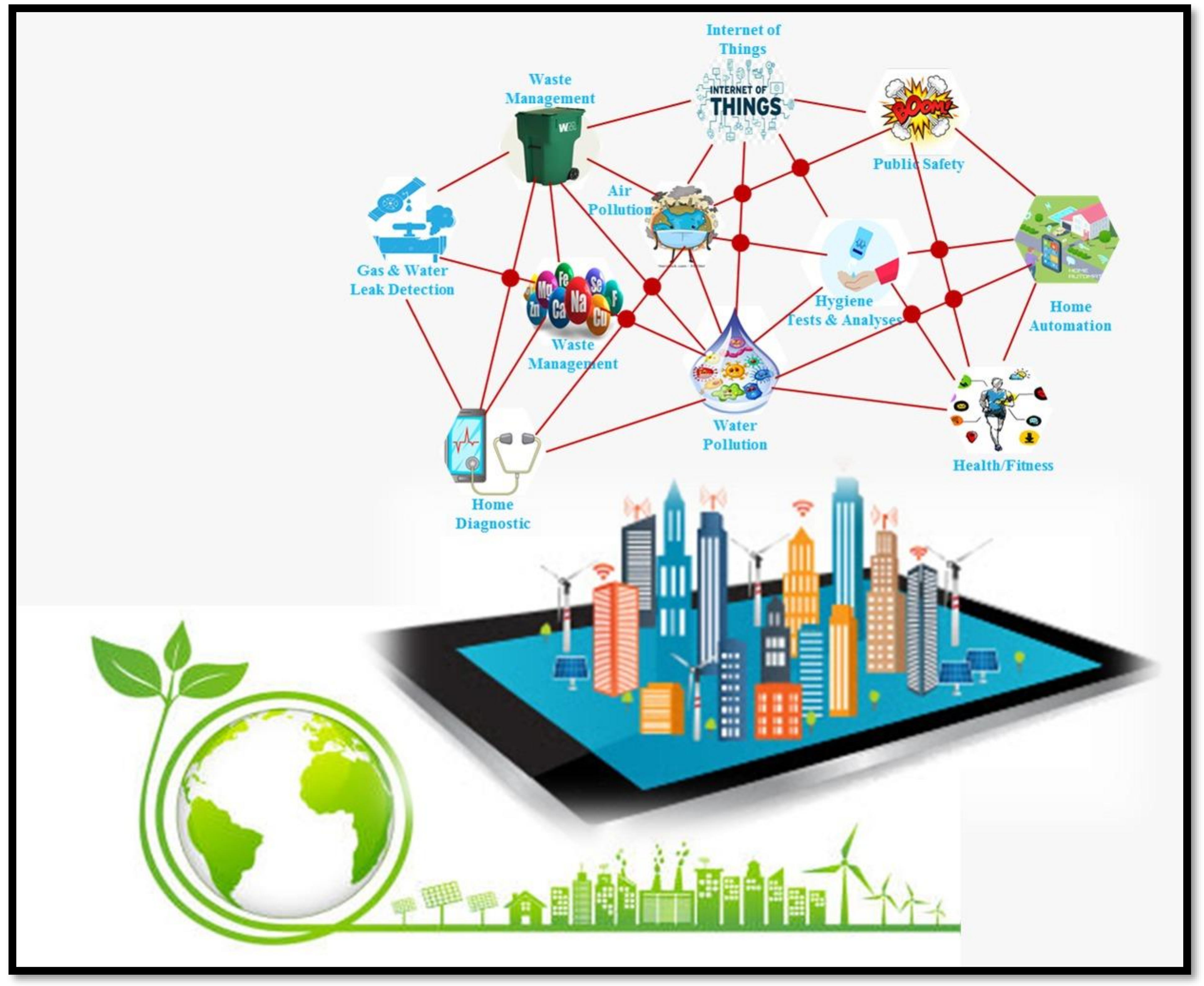
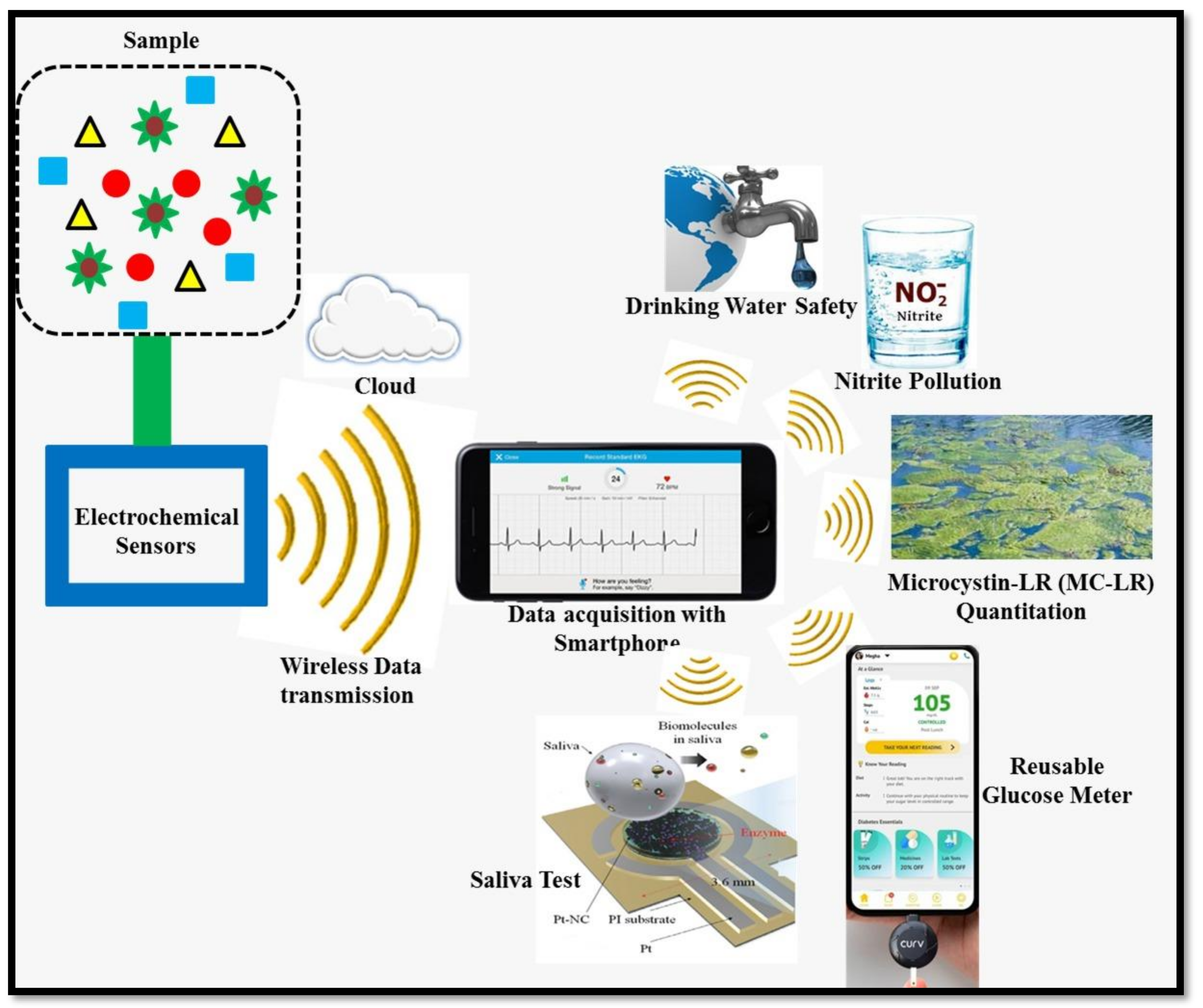
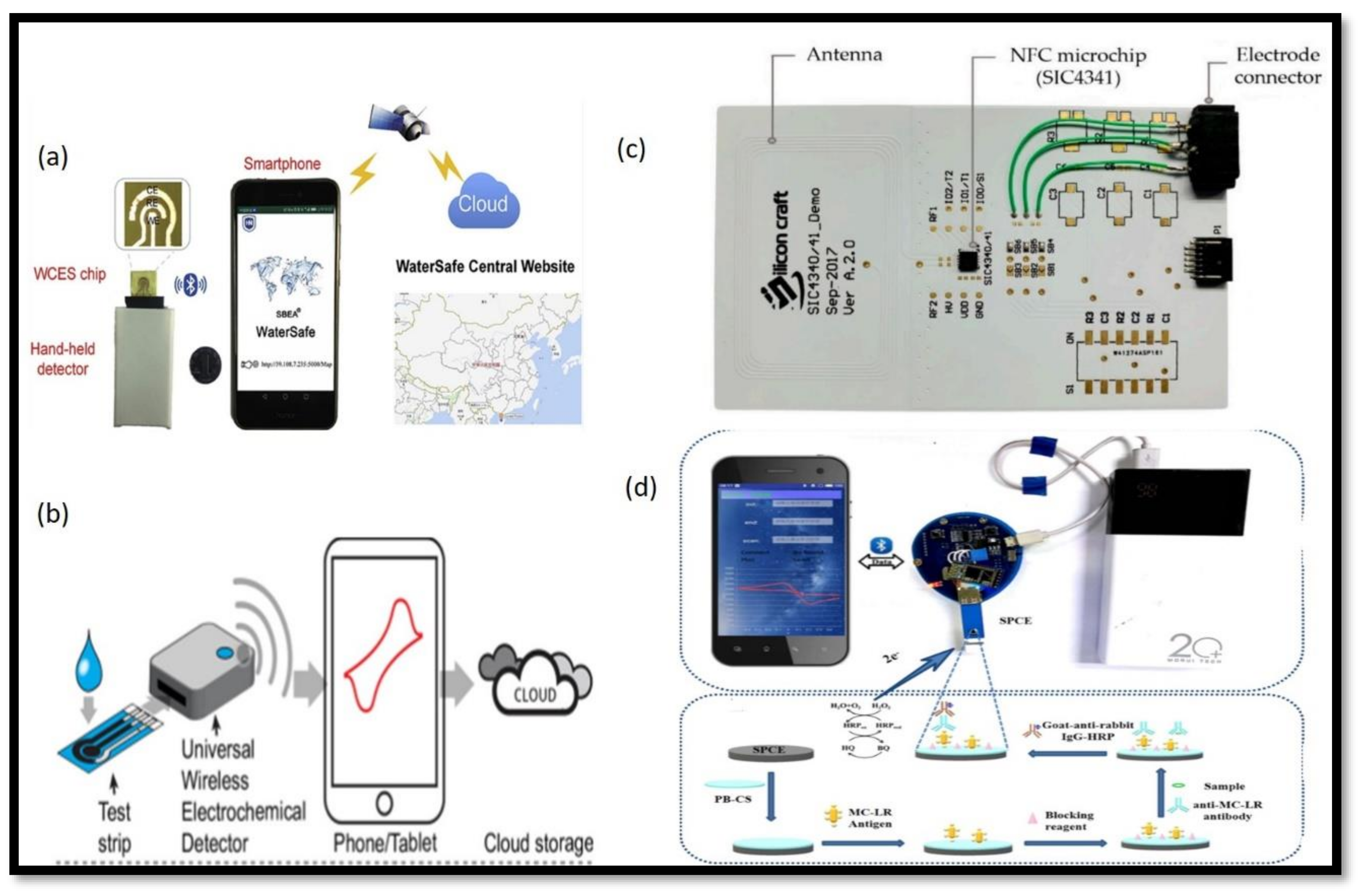
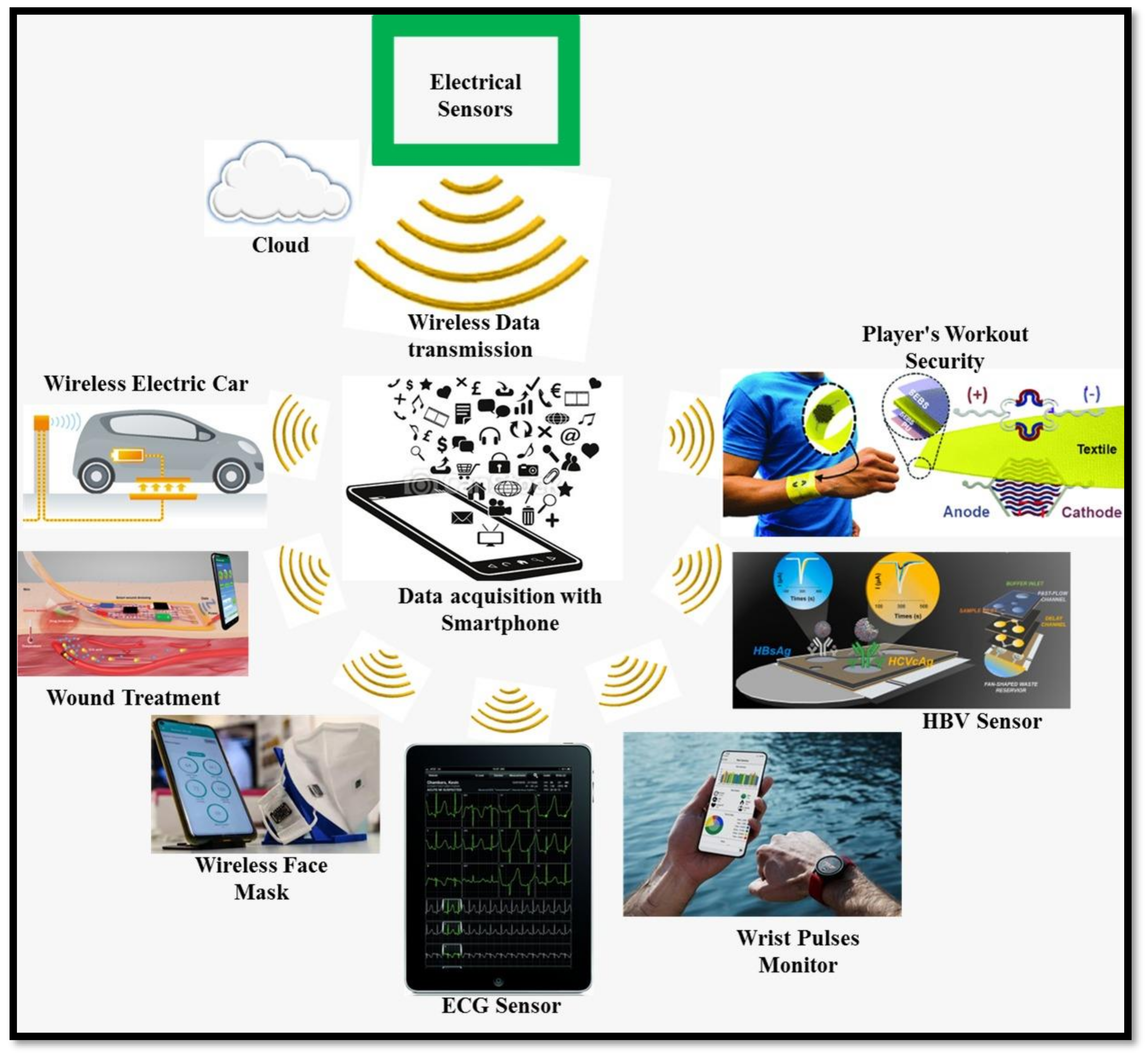
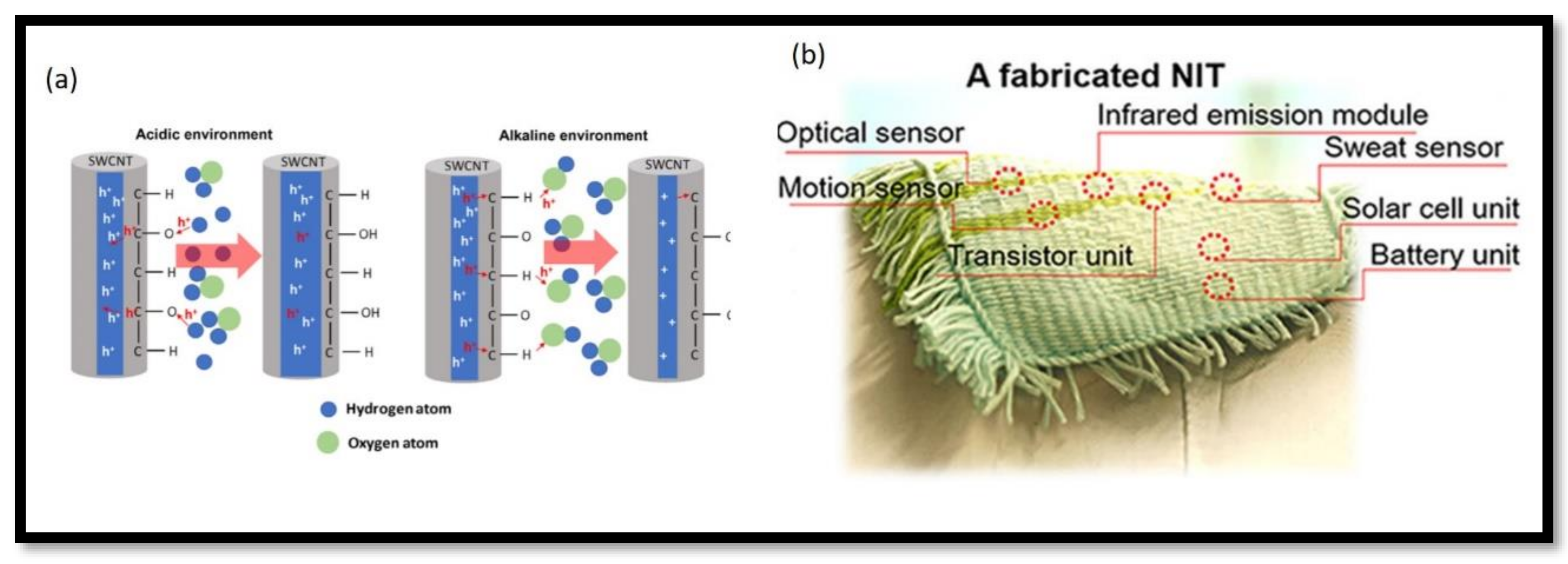
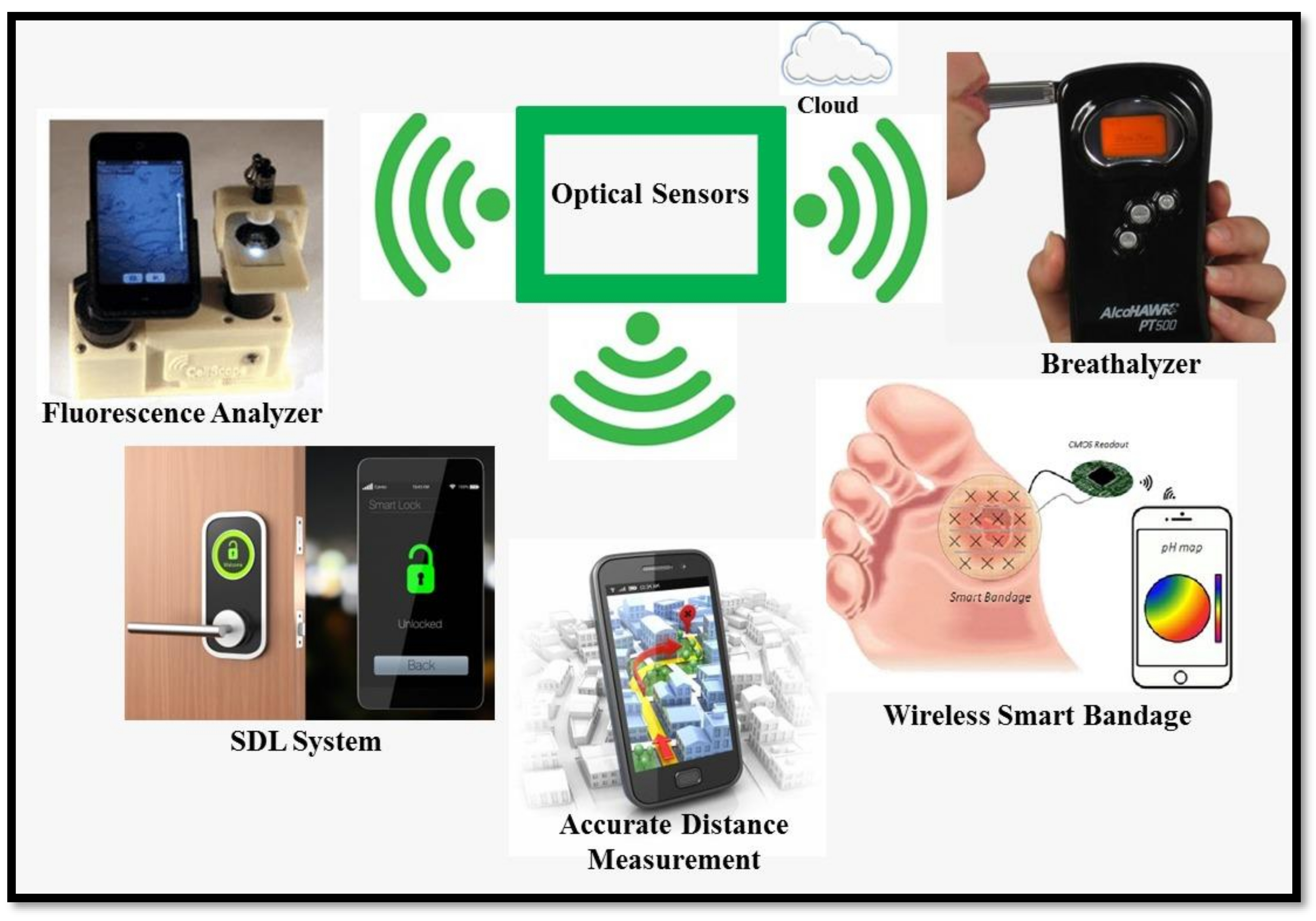
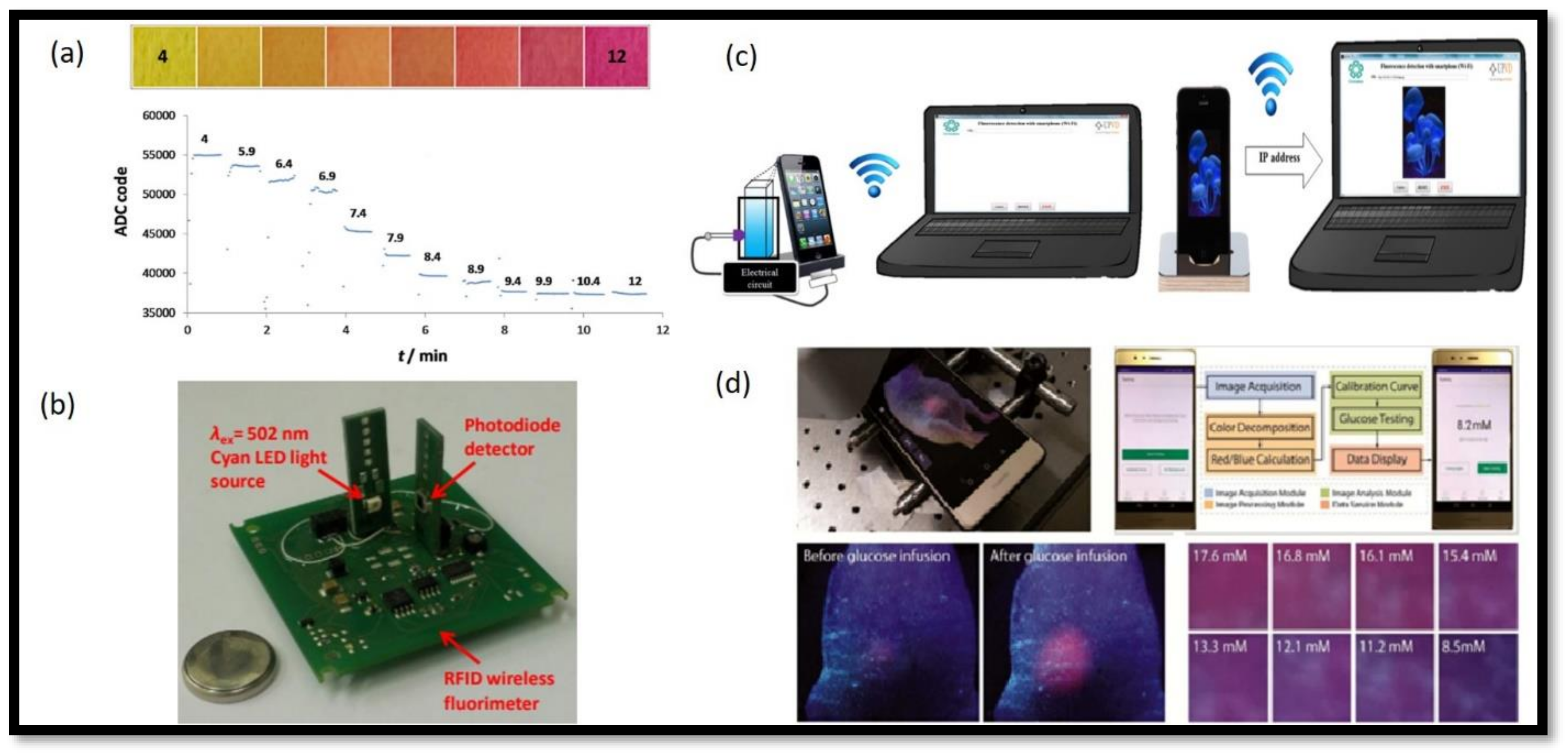
Publisher’s Note: MDPI stays neutral with regard to jurisdictional claims in published maps and institutional affiliations. |
© 2022 by the authors. Licensee MDPI, Basel, Switzerland. This article is an open access article distributed under the terms and conditions of the Creative Commons Attribution (CC BY) license (https://creativecommons.org/licenses/by/4.0/).
Share and Cite
Chandra Kishore, S.; Samikannu, K.; Atchudan, R.; Perumal, S.; Edison, T.N.J.I.; Alagan, M.; Sundramoorthy, A.K.; Lee, Y.R. Smartphone-Operated Wireless Chemical Sensors: A Review. Chemosensors 2022, 10, 55. https://doi.org/10.3390/chemosensors10020055
Chandra Kishore S, Samikannu K, Atchudan R, Perumal S, Edison TNJI, Alagan M, Sundramoorthy AK, Lee YR. Smartphone-Operated Wireless Chemical Sensors: A Review. Chemosensors. 2022; 10(2):55. https://doi.org/10.3390/chemosensors10020055
Chicago/Turabian StyleChandra Kishore, Somasundaram, Kanagesan Samikannu, Raji Atchudan, Suguna Perumal, Thomas Nesakumar Jebakumar Immanuel Edison, Muthulakshmi Alagan, Ashok K. Sundramoorthy, and Yong Rok Lee. 2022. "Smartphone-Operated Wireless Chemical Sensors: A Review" Chemosensors 10, no. 2: 55. https://doi.org/10.3390/chemosensors10020055
APA StyleChandra Kishore, S., Samikannu, K., Atchudan, R., Perumal, S., Edison, T. N. J. I., Alagan, M., Sundramoorthy, A. K., & Lee, Y. R. (2022). Smartphone-Operated Wireless Chemical Sensors: A Review. Chemosensors, 10(2), 55. https://doi.org/10.3390/chemosensors10020055










